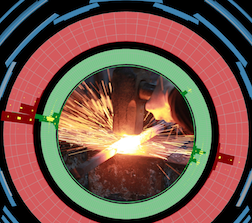Speaker
Description
We consider a concise dark matter scenario in the minimal gauged $B-L$ extension of the Standard Model (SM), where the global $B-L$ (baryon number minus lepton number) symmetry in the SM is gauged,
and three generations of right-handed neutrinos and a $B-L$ Higgs field are introduced.
Associated with the $B-L$ gauge symmetry breaking by a VEV of the $B-L$ Higgs field,
the seesaw mechanism for generating the neutrino mass is automatically implemented
after the electroweak symmetry breaking in the SM.
In this model context, we introduce a $Z_2$-parity and assign an odd parity
for one right-handed neutrino while even parities for the other fields.
Therefore, the dark matter candidate is identified as the right-handed Majorana neutrino with odd $Z_2$ parity,
keeping the minimality of the particle content intact.
When the dark matter particle communicates with the SM particles
mainly through the $B-L$ gauge boson ($Z^\prime_{BL}$ boson),
its relic abundance is determined by only three free parameters, the $B-L$ gauge coupling ($\alpha_{BL}$),
the $Z^\prime_{BL}$ boson mass ($m_{Z^\prime}$) and the dark matter mass ($m_{DM}$).
With the cosmological upper bound on the dark matter relic abundance
we find a lower bound on $\alpha_{BL}$ as a function of $m_{Z^\prime}$.
On the other hand, we interpret the recent LHC Run-2 results on search for $Z^\prime$ boson resonance
to an upper bound on $\alpha_{BL}$ as a function of $m_{Z^\prime}$.
Combining the two results we identify an allowed parameter region for this ``$Z^\prime_{BL}$ portal'' dark matter scenario,
which turns out to be a narrow window with the lower mass bound of $m_{Z^\prime} > 2.5$ TeV.
